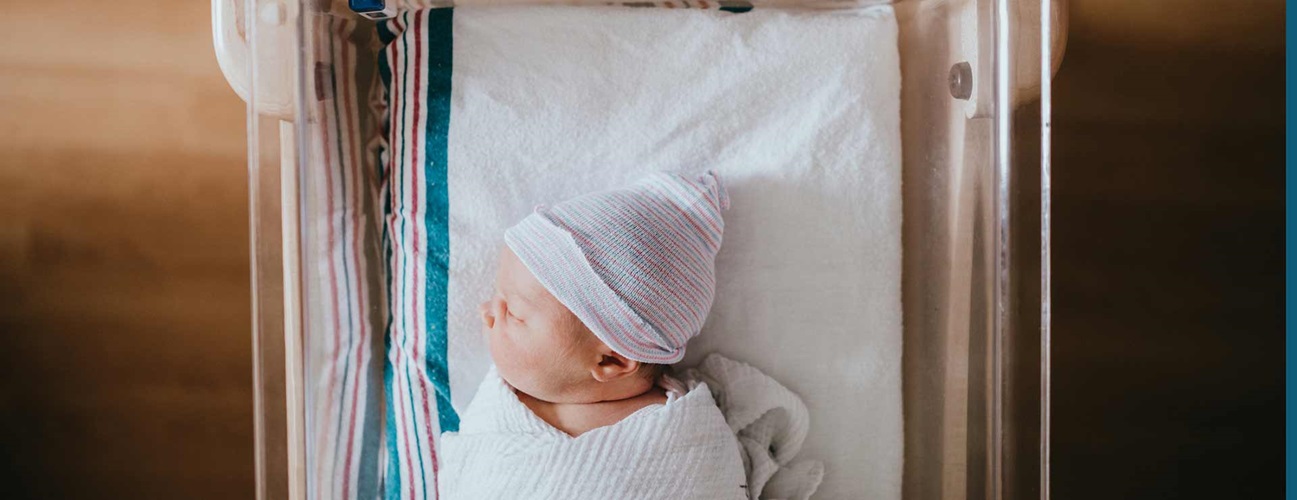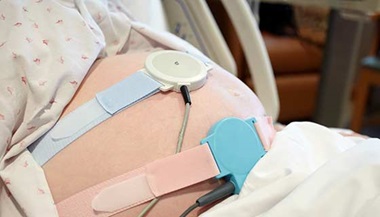Care of the Baby in the Delivery Room
The birth of a baby is one of life's most wondrous moments. Few experiences compare to this event. Newborn babies have amazing abilities. Yet they are dependent on others for feeding, warmth, and comfort.
Amazing physical changes occur with birth. When the baby is delivered, the umbilical cord is clamped and cut near the navel. This ends the baby's dependence on the placenta for oxygen and nutrition. As the baby takes its first breath, air moves into the lungs. Before birth, the lungs are not used to exchange oxygen and carbon dioxide, and need less blood supply. The fetal circulation sends most of the blood supply away from the lungs through special connections in the heart and the large blood vessels. When a baby starts to breathe air at birth, the change in pressure in the lungs helps close the fetal connections and redirect the blood flow. Now blood is pumped to the lungs to help with the exchange of oxygen and carbon dioxide. Some babies have too much fluid in their lungs. Stimulating the baby to cry by massage and stroking the skin can help bring the fluid up where it can be suctioned from the nose and mouth.
Providing warmth for the newborn
A newborn baby is wet from the amniotic fluid and can easily become cold. Drying the baby and using warm blankets and heat lamps can help prevent heat loss. Often a knitted hat is placed on the baby's head. Placing a baby skin-to-skin on your chest or abdomen also helps to keep the baby warm. This early skin-to-skin contact also reduces crying, improves your interaction with your baby, and helps you to breastfeed successfully.
Immediate care for the newborn
Health assessments of the new baby start right away. One of the first checks is the Apgar test. The Apgar test is a scoring system to evaluate the condition of the newborn at 1 minute and 5 minutes after birth. The healthcare provider or midwife and nurses will evaluate these signs and give a point value:
Activity; muscle tone
Pulse rate
Grimace; reflex irritability
Appearance; skin color
Respiration
A score of 7 to 10 is considered normal. A score of 4 to 6 may mean that the baby needs some rescue breathing measures (oxygen) and careful monitoring. A score of 3 or below means that the baby needs rescue breathing and lifesaving techniques.
Physical exam of the newborn in the delivery room
A brief, physical exam is done to check for obvious signs that the baby is healthy. Other procedures will be done over the next few minutes and hours. These may be done in the delivery room, in the nursery, or in your room, depending on the hospital policy and the condition of the baby. Some of these procedures include:
Measurement of the temperature, heart rate, and respiratory rate
Measurement of weight, length, and head circumference. These measurements help find out if a baby's weight and measurements are normal for the number of weeks of pregnancy. Small or underweight babies and very large babies may need special attention and care.
Cord care. The baby's umbilical cord stump will have a clamp. It needs to be kept clean and dry.
Bath. Once a baby's temperature has stabilized, the first bath can be given.
Eye care. Bacteria in the birth canal can infect a baby's eyes. Your baby will be given antibiotic or antiseptic eye drops or ointment either right after delivery or later in the nursery to prevent eye infection.
Footprints. These are often taken and recorded in the medical record.
Before a baby leaves the delivery area, ID bracelets with matching numbers are placed on the baby and on you. Babies often have 2, on the wrist and ankle. These should be checked each time the baby comes or goes from your room.
Care for the newborn after a vaginal delivery
Healthy babies born in a vaginal delivery are usually able to stay with the mother. In many hospitals, immediate newborn assessments include weight, length, and medicines. Even the first bath is done right in your room. As quickly as possible, a new baby is placed in your arms. Often, the baby is placed skin-to-skin on your chest right after birth. Some babies will breastfeed right away.
In the first hour or 2 after birth, most babies are in an alert, wide awake phase. This offers a chance for you and your partner to get to know your new baby. A baby will often turn to the familiar sound of the mother's voice. A baby's focus of vision is best at about 8 to 12 inches--just the distance from the baby cradled in your arms to your face.
This first hour or 2 after birth is also the best time to start breastfeeding. Babies have an innate ability to start nursing right away after they are born. Some medicines and anesthesia given to you during labor and delivery may affect the baby's sucking ability. But most healthy babies are able to breastfeed in these first few hours. This first feeding helps stimulate breastmilk production. It also causes your uterus to contract. This can help prevent too much bleeding.
Care for the newborn after a C-section
If your baby is born by a cesarean, chances are good that you can be awake for the surgery. Only in rare cases will you need general anesthesia for delivery. This means you are not awake for the birth. Most C-sections today are done with a regional anesthesia such as an epidural or spinal. With this type of anesthesia, only part of the body is numbed for surgery. You are awake and able to hear and see your baby as soon as he or she is born.
Babies born by C-section are usually checked by a nursery nurse or healthcare provider right after delivery. This is often done right near you in the operating room. Because babies born by C-section may have trouble clearing some of the lung fluid and mucus, they often need extra suctioning of the nose, mouth, and throat. In some cases, they may need deeper suctioning in the windpipe.
Once a baby is checked over, a nurse will wrap the baby warmly and bring the baby to you to see and touch. Many hospitals require babies born by C-section to be watched in the nursery for a short time. All the usual procedures such as weighing and medicines are done there. Usually, your baby can be brought to you while you are in the recovery area after surgery.
Many mothers think that they will not be able to breastfeed after a C-section. This is not true. Breastfeeding can start in the first hours right in the recovery room, just as with a vaginal delivery.
Plan to have someone stay with you during your hospital stay after a C-section. You will have quite a bit of pain in the first few days and will need help with the baby.
When a baby has trouble after birth
All the baby's body systems must work together in a new way after birth. Sometimes a baby has trouble making the transition. Health assessments such as the Apgar test done right after birth can help find out if a baby is doing well or having problems.
If there are signs the baby is not doing well, treatment can be given right in the delivery room. The healthcare provider or midwife and other members of the healthcare team work together to help the baby clear excess fluid and start breathing.
Babies who may have trouble at birth include those born prematurely, those born with a difficult delivery, or those born with a birth defect. Fortunately, special care is available for these babies. Newborn babies who need intensive medical care are often admitted into a special area of the hospital called the neonatal intensive care unit (NICU). The NICU combines advanced technology and trained health staff to give special care to the tiniest patients. NICUs may also have intermediate or continuing care areas for babies who are not as sick, but need special nursing care. Some hospitals don't have a NICU. Babies may need to be transferred to another hospital.
Having a sick baby can be stressful. Few parents expect complications of pregnancy or their baby to be sick or premature. It is quite natural for parents to have many different emotions as they try to cope with the difficulties of a sick baby. But it is reassuring that today's advanced technology is helping sick babies get better and go home sooner than ever before. It also helps to know that although separation from a baby is painful, it does not harm the relationship between mother and baby.




